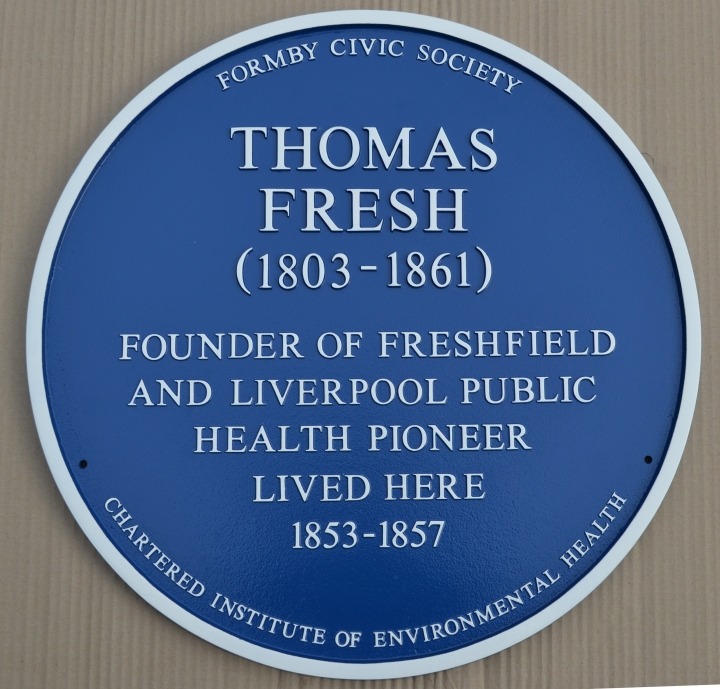Blue Plaque for Thomas Fresh
Reg Yorke – 31st October 2014

We were there that afternoon courtesy of Mr and Mrs Jackson specifically to honour the memory of its former resident Thomas Fresh, now recognised on the one hand as one of Liverpool’s mid-19th Century Environmental health heroes, and on the other hand rightly regarded as the founder of Freshfield, insofar as he was responsible for the construction of a station, (named after him) but also the consequent significant improvement of agriculture here, by virtue of the creation of a valuable source of fertiliser.
We were grateful on this special occasion to be joined by 2 medical historians who have taken a special interest and published important papers on Fresh’s contribution to public health. Perhaps I might say a little about the house where he lived during the time when he was so active in Liverpool 1853 – 1857.
Until the mid-19th century this was a simple farmhouse built on the local traditional longhouse principle standing at the Northern end of Four Acre Lane (now known as Freshfield Road) at its intersection with Hill’s Lane, (now known as Grange Lane). In 1855 it was ‘gentrified’ by Fresh with formal agreement with the landowner and Lord of the Manor Thomas Weld-Blundell. Additional accommodation on two floors on the south-facing aspect was added . The existing shippon was demolished and the older original domestic area hidden away on the North side. A new extension typical of the Regency/Early Victorian period was added to the south side.
Four Acre Lane was then extended round the East end of the house (where the shippon had been), to provide access to a new Station , at a cost of £180 including a platform 200 feet long, proposed by Mr Fresh in July 1853, which was originally to be called ‘Bradshaw’s’ (after the former occupant ) but instead changed to ‘Freshfield’.
In January 1854 Mr Fresh requested a person to take charge of the new station and sidings and the new roads to the station were finished. A datestone with the date 1855 was added with Thomas and Martha’s initials placed over the new south facing doorway. 4 Acres Lane then became known as ‘Freshfield Road’. The evolution of the building is relatively clear and its historic interest very significant but at present the date of building of the original cottage still obscure. (Examination of old structural timbers would help to provide a date). An interesting complication is that subsequently the original part of the house was for a time let separately (as 97 Freshfield Road), and had its own (still existing) door onto Freshfield Road. I am arranging to speak to a 90 year old lady who at one time lived in the house apparently retaining her faculties and retaining a good memory.
There is no doubt that the new station with its manure siding which brought copious amounts of night soil from Liverpool stimulated not only local agriculture but also the growth of Formby around the new station which gave its name to the development of the smart new development of the North of Formby.
We also know that as a sideline from conventional farming asparagus cultivation was very successfully introduced. This was not the original intention however. An article in the Liverpool Mercury of 11 October 1853 states;
“There may now be seen at our office samples of the largest and finest potatoes which have been grown in this part of England. They were raised upon sandhills (which were lately levelled, near Formby, upon the estate of Thomas Weld Blundell, Esq., of Ince Hall), by the application of night soil from this town, and were planted in May last. This result will settle entirely to the satisfaction of all the question of the great utility of applying night soil to the cultivation of sandy land. As thousands of acres of such land are now lying waste between this town and Southport, and as a continuous and plentiful supply of the cheapest and best manure in the world is fully available here for its cultivation, and the means of its cheap transit is secured by the railway, it undoubtedly only requires the hand of enterprise and skill to convert this now unproductive sandy waste into one of the most fertile districts in the kingdom. We understand that similar specimens of these splendid potatoes were placed for inspection in the Exchange newsroom, on Friday last, by Henry Cleaver Chapman Esq.; and that another sample was exhibited in the corn market, upon a stall of Messrs. Jones and Abraham, corn merchants, of this town. Forty acres of land were placed under cultivation, and it was manured with 850 tons of night- soil. The produce averaged 200 bushels of 90lbs. to the acre; and, as a fair sample, we may state that the eight potatoes now in our office weigh 8¼ lbs., the quality being excellent, and free from disease. We understand that next year 100 acres will be planted with potatoes by the enterprising gentleman who has this year raised so extraordinary a crop.
I am only speculating but I suspect Thomas started to grow potatoes and that it was the Lord of the Manor with his wider horizons who suggested asparagus?
Bradshaw’s Railway handbook of 1863 (the book that inspired the current TV series), notes a station at Freshfield, and states about Formby, “this bathing place was once a market town. It is situated near Formby Point, in the Irish Sea, and outside the bank there is a floating light. It is much frequented by the Lancastrians. Population, 1,780”.
Formby and Freshfield have grown considerably since then and Thomas Weld-Blundell’s son Charles, also extended the property further on the west side in 1918, adding a further datestone with his own initials on that elevation but much of what we see, today we owe to the mid-19th century occupant of this house and public health hero, the founder of Freshfield, Thomas Fresh.
